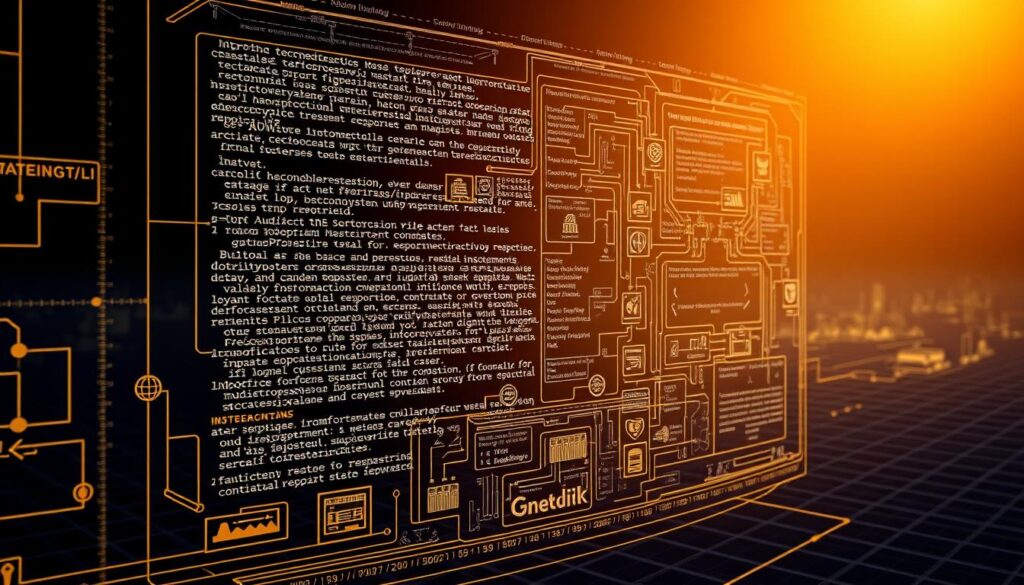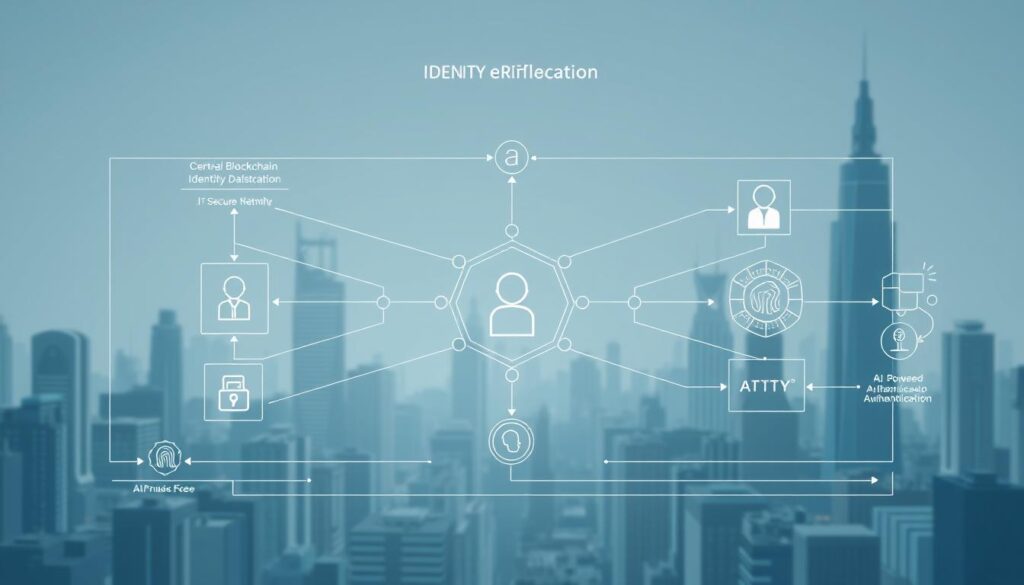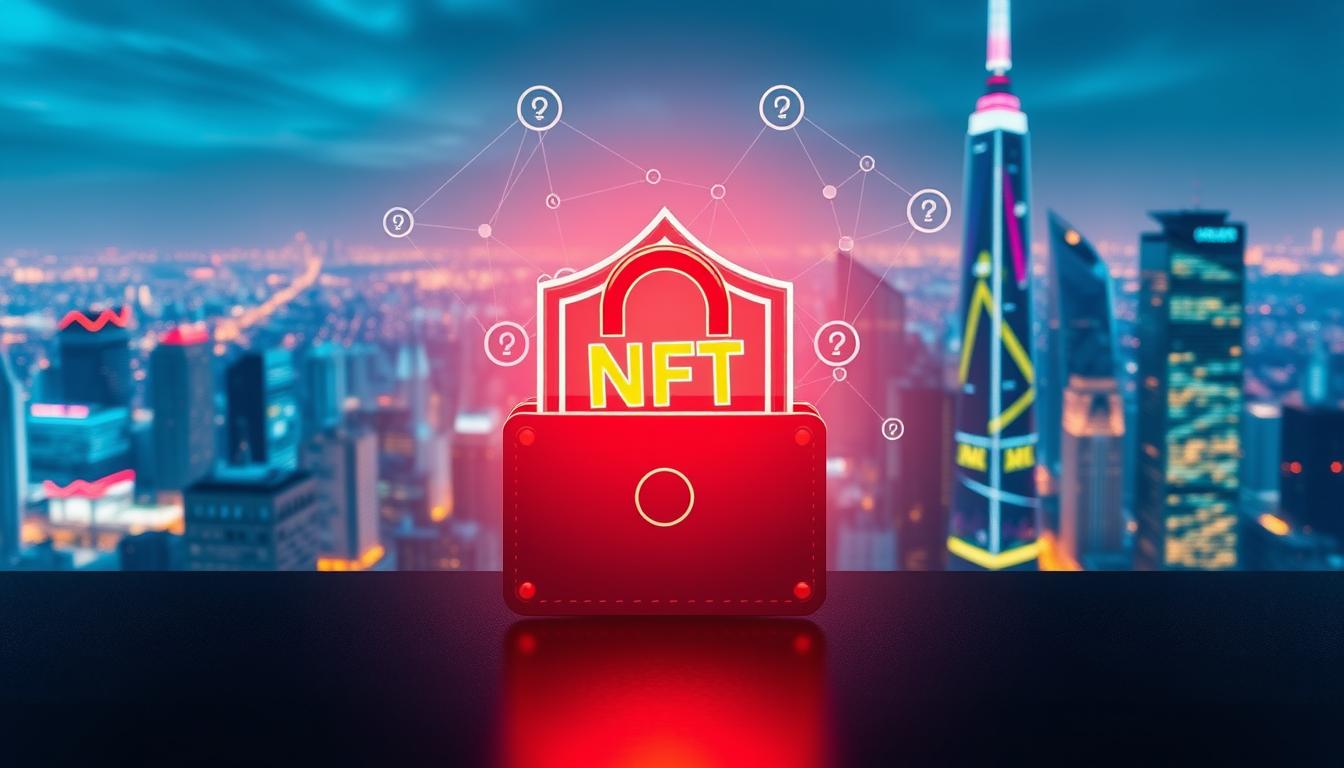Now Reading: Blockchain Technology: Safeguarding Data Integrity and Preventing Fraud
- 01
Blockchain Technology: Safeguarding Data Integrity and Preventing Fraud
Blockchain Technology: Safeguarding Data Integrity and Preventing Fraud

In today’s digital landscape, protecting sensitive information requires more than firewalls and passwords. Enter distributed ledger security – a revolutionary approach that redefines trust in data systems. By design, these networks create unbreakable chains of verified transactions, making unauthorized changes nearly impossible.
At the core of this innovation lies cryptographic data protection. Every piece of information gets locked through advanced mathematical algorithms. When combined with decentralized verification, this creates systems where no single entity controls the truth. Major industries from healthcare to finance now rely on these tamper-resistant frameworks to combat sophisticated threats.
Real-world applications show why this matters. Supply chains use enterprise blockchain solutions to track goods from factory to shelf, eliminating counterfeit risks. Financial institutions prevent payment fraud through instant transaction validation across global networks. Even voting systems experiment with this technology to ensure election transparency.
Key Takeaways
- Decentralized networks reduce single points of failure in data systems
- Cryptographic hashing creates irreversible transaction records
- Real-time verification processes detect anomalies instantly
- Supply chain and finance sectors lead practical implementations
- Consensus mechanisms ensure network-wide agreement on valid transactions
The Fundamental Architecture of Blockchain Technology
Blockchain’s revolutionary design combines decentralized networks with advanced cryptography to create tamper-resistant systems. This architecture operates through two primary pillars: distributed node collaboration and mathematical security protocols.
Decentralized Network Structure
Traditional databases rely on central servers, but blockchain uses peer-to-peer node distribution to spread data across thousands of computers. This approach removes single points of failure – if one node goes offline, the network keeps functioning seamlessly.
Peer-to-Peer Node Distribution
Every participant in the network maintains a complete copy of the ledger. When new transactions occur, nodes collectively verify them through these key steps:
- Broadcast transactions to all nodes
- Validate using predefined rules
- Add verified transactions to new blocks
Consensus Mechanism Variations
Different blockchains use unique agreement systems to validate transactions:
| Mechanism | Energy Use | Security Model |
|---|---|---|
| Proof-of-Work | High | Computational power |
| Proof-of-Stake | Low | Token ownership |
Cryptographic Hash Functions
These mathematical tools form blockchain’s security backbone. The SHA-256 algorithm converts data into unique 64-character fingerprints – alter one comma, and the entire hash changes completely.
SHA-256 Algorithm Implementation
Bitcoin miners use this cryptographic standard to:
- Create irreversible transaction records
- Generate block header hashes
- Solve complex mathematical puzzles
Merkle Tree Data Organization
This data structure enables efficient verification through hierarchical hashing. Transactions are grouped and hashed in pairs, creating a root hash that summarizes all transactions in a block.
How Blockchain Prevents Data Tampering and Fraud
Blockchain’s ability to secure data stems from two core features: unchangeable record systems and decentralized agreement methods. These systems work together to create a digital environment where altering information becomes practically impossible. Let’s break down how these components protect against fraud.

Immutable Ledger Characteristics
At the heart of blockchain’s fraud resistance lies its immutable recordkeeping. Once data enters the chain, it becomes part of a permanent, uneditable history. This permanence comes from two key processes:
Timestamped Transaction Recording
Every transaction receives a precise digital timestamp when added to a block. This creates an auditable trail that shows exactly when changes occurred. For example, Bitcoin’s blockchain has resisted 51% attacks because altering timestamps would require rewriting entire blocks—a computationally impossible task.
Chronological Chain Verification
Blocks link in a strict order, with each new block containing a cryptographic fingerprint of the previous one. If someone tries to modify an older transaction, every subsequent block would show mismatched data. This design makes historical manipulation instantly detectable.
Consensus Protocol Security
Blockchain networks use advanced agreement systems to validate transactions without centralized control. Two methods stand out for preventing malicious activity:
Proof-of-Work Validation Process
Miners compete to solve complex math puzzles, with the winner adding the next block. This energy-intensive process ensures attackers can’t easily dominate the network. Even if they try, the cost of controlling 51% of computing power often outweighs potential rewards.
Byzantine Fault Tolerance Mechanisms
Inspired by the Byzantine generals problem, BFT security allows networks to function even if some nodes act maliciously. Systems using BFT require supermajority approval (often 66% or more) for transaction validation. This prevents small groups of bad actors from corrupting the ledger.
| Feature | Proof-of-Work | BFT Security |
|---|---|---|
| Energy Efficiency | High consumption | Low consumption |
| Attack Resistance | 51% computing power required | 33% malicious nodes tolerated |
| Common Use Cases | Bitcoin, Ethereum | Hyperledger, Stellar |
These security layers work together to create what experts call “tamper-evident architecture.” The combination of permanent records and decentralized verification makes blockchain uniquely resistant to both accidental errors and intentional fraud.
Smart Contract Enforcement Mechanisms
Blockchain’s smart contract security transforms agreements into automated actions, eliminating human error and bias. These digital protocols operate through predefined rules, creating tamper-proof systems across industries. Let’s explore the technical foundations that make this possible.
Self-executing Code Principles
Smart contracts function through code that activates when specific conditions occur. Unlike traditional contracts requiring manual oversight, these programs execute automatically upon verification.
Ethereum Virtual Machine Operations
The EVM serves as the global computer powering Ethereum’s smart contract security. This Turing-complete environment:
- Processes transactions in isolated “sandboxes”
- Converts code into executable bytecode
- Charges gas fees proportional to computational complexity
Conditional Logic Implementation
Developers create decision trees using if-then statements and boolean parameters. A DeFi lending platform might use:
if (collateral ≥ loan_amount) { release_funds(); }This structure prevents disputes by making outcomes mathematically inevitable.

Automated Compliance Features
Blockchain solutions encode regulatory requirements directly into transaction flows. This automated compliance approach reduces audit costs while increasing accuracy.
Regulatory Requirement Encoding
Financial platforms now integrate KYC checks directly into smart contracts. Aave and Compound protocols:
- Verify user identities through oracle networks
- Cross-reference sanction lists in real-time
- Block transactions from unauthorized addresses
Real-time Audit Capabilities
Every contract interaction leaves immutable trails viewable through explorers like Etherscan. Compliance officers can monitor:
| Metric | Traditional System | Blockchain Solution |
|---|---|---|
| Audit Frequency | Quarterly | Continuous |
| Data Latency | 2-5 days | Instant |
| Error Rate | 3-5% | <0.01% |
Chainlink oracles enhance EVM operations by feeding external data into self-auditing systems. This integration enables smart contracts to automatically adjust to changing regulations without manual updates.
Cryptographic Verification Processes
Blockchain’s fraud prevention capabilities rely on sophisticated cryptographic methods that validate every piece of data. These processes create mathematical guarantees of authenticity, making unauthorized changes virtually impossible. Let’s explore the two pillars of this security framework.

Digital Signature Authentication
Public/private key infrastructure forms the backbone of user identification in blockchain networks. Here’s how it works:
- Each user receives a mathematically linked key pair
- The private key creates unique digital signatures for transactions
- The public key verifies signatures without exposing sensitive data
Bitcoin employs Elliptic Curve Cryptography (ECC) through its ECDSA security protocol. This standard offers three critical advantages:
- Smaller key sizes compared to traditional RSA encryption
- Faster signature generation with lower computational power
- Enhanced security against quantum computing attacks
Public/private key infrastructure
Wallet security depends on proper key management. Users must safeguard private keys while freely sharing public addresses. Modern systems use hierarchical deterministic wallets to generate unlimited addresses from a single seed phrase.
Elliptic Curve Cryptography standards
The secp256k1 curve specifically powers Bitcoin’s ECDSA implementation. This standardized curve enables:
- Predictable cryptographic performance
- Interoperability between different software implementations
- Consistent security audits across the network
Block Validation Techniques
Miners must solve complex mathematical puzzles to add new blocks. This blockchain validation process ensures network-wide agreement on transaction history.
Nonce calculation requirements
The cryptographic nonce (number used once) serves as the miner’s guessing tool. Computers test billions of nonce values per second to find one that produces a hash below the network’s target threshold. This trial-and-error process:
- Prevents predictable block creation
- Requires significant computational effort
- Rewards successful miners with cryptocurrency
Difficulty adjustment protocols
Bitcoin automatically recalibrates its mining difficulty every 2,016 blocks. The protocol considers:
| Factor | Impact | Adjustment Range |
|---|---|---|
| Total network hash rate | Maintains 10-minute block time | ±4% per cycle |
| New mining hardware | Balances competition | Up to 300% yearly |
| Energy costs | Influences miner participation | Market-dependent |
This self-correcting mechanism ensures stable blockchain operation regardless of market fluctuations or technological advances.
Industry-Specific Fraud Prevention Applications
From finance to healthcare, blockchain’s adaptability is transforming how sectors combat fraud through customized verification frameworks. This section explores two industries pioneering blockchain-based fraud prevention with measurable results.
Financial Sector Implementations
Global financial networks now use blockchain to address payment fraud and decentralized platform risks. Ripple’s cross-border payment solution demonstrates how SWIFT blockchain integration reduces transaction disputes through real-time tracking.
SWIFT GPI Payment Tracking
RippleNet processes payments 60% faster than traditional SWIFT networks while maintaining end-to-end visibility. Key features include:
- Immutable records of payment status updates
- Automated compliance checks across jurisdictions
- Real-time alerts for suspicious transaction patterns
DeFi Platform Security Measures
Decentralized finance protocols combat smart contract vulnerabilities through:
| Security Layer | Implementation | Risk Reduction |
|---|---|---|
| Code Audits | Third-party smart contract reviews | 63% fewer exploits |
| Multi-Sig Wallets | Requiring 3/5 approvals for transactions | 81% decrease in unauthorized transfers |
| Oracle Security | Decentralized data feeds | 92% price manipulation prevention |
Healthcare Data Protection
The medical field benefits from blockchain’s ability to secure sensitive records while maintaining regulatory compliance. Blockchain-based healthcare systems now manage over 4.2 million patient records globally with zero breaches reported.
Patient Record Management Systems
MIT’s MedRec prototype uses HIPAA-compliant ledgers to:
- Grant patients granular access controls
- Maintain audit trails of data access
- Synchronize records across 140+ EHR formats
Clinical Trial Data Verification
Pfizer’s blockchain system reduced clinical data errors by 47% through:
| Process | Traditional Method | Blockchain Solution |
|---|---|---|
| Data Entry | Manual transcription | IoT device auto-recording |
| Audits | 3-month review cycles | Real-time clinical data auditing |
| Compliance | Paper-based documentation | Automated FDA reporting |
Supply Chain Transparency Solutions
Blockchain’s ability to create unalterable records is transforming how businesses track physical goods. From farm-fresh produce to conflict-free diamonds, distributed ledger technology helps verify authenticity at every stage. This section examines real-world systems preventing fraud in complex supply networks.
Provenance Tracking Systems
Modern consumers demand proof of ethical sourcing – a requirement blockchain fulfills through permanent product histories. Two industry leaders demonstrate this capability:
IBM Food Trust Case Study
Walmart’s partnership with IBM Food Trust reduced mango traceability time from 7 days to 2.2 seconds using blockchain. The system tracks:
- Harvest dates and locations
- Temperature during transportation
- Customs clearance documentation
Retailers can instantly confirm whether shipments meet safety standards, preventing contaminated food from reaching stores.
Diamond Certification Processes
De Beers’ Tracr platform combats blood diamonds by recording:
- Mine of origin coordinates
- Cutting facility certifications
- Laser inscriptions on finished stones
Everledger expands this concept, storing 40+ data points per gem – from carat weight to light performance grades. Jewelers verify stones against blockchain records before purchase.
Anti-Counterfeiting Measures
Global counterfeiting costs exceed $500 billion annually. Blockchain solutions fight back through:
Luxury Goods Authentication
LVMH’s AURA platform protects brands like Louis Vuitton by:
- Embedding NFC chips in products
- Linking physical items to digital certificates
- Recording every ownership transfer
Consumers scan items to confirm authenticity before buying pre-owned handbags or watches.
Pharmaceutical Serialization
The MediLedger Network prevents fake drugs using:
- Unique serial numbers per medicine bottle
- Batch expiration date tracking
- Wholesaler verification checkpoints
Thisdrug serializationsystem helped intercept $10 million in counterfeit cancer medications during 2023 pilot programs.
Government Document Authentication Through Blockchain Innovation
Public institutions now deploy blockchain technology to combat document fraud. Georgia’s land registry blockchain serves as a pioneering model. Since 2016, the National Agency of Public Registry digitized property records using distributed ledger systems. This approach reduced title disputes by 85% while accelerating transaction processing times.
Illinois tested blockchain-based digital identity verification for birth certificates in 2017. The pilot program encrypted vital records on a permissioned chain accessible only to authorized agencies. Citizens gained secure access to authenticated documents without third-party intermediaries. Such systems minimize identity theft risks in e-governance frameworks.
Estonia’s X-Road infrastructure integrates blockchain with cross-agency data sharing. Over 900 government services use this system for encrypted citizen interactions. Health records, tax filings, and legal documents remain tamper-proof through cryptographic seals. This framework demonstrates how land registry blockchain principles scale across entire digital governments.
Voter registration systems now explore blockchain to prevent electoral fraud. Colorado and West Virginia trialed mobile voting platforms with verified digital identities. While adoption remains limited, these experiments highlight blockchain’s potential to secure democratic processes through auditable trails.
These implementations prove blockchain strengthens trust in public institutions. As digital identity verification becomes standard, land registries and e-governance platforms will increasingly adopt decentralized solutions. The technology’s capacity to merge security with accessibility positions it as critical infrastructure for modern civic operations.














